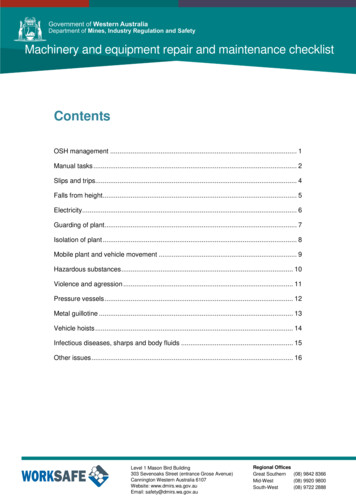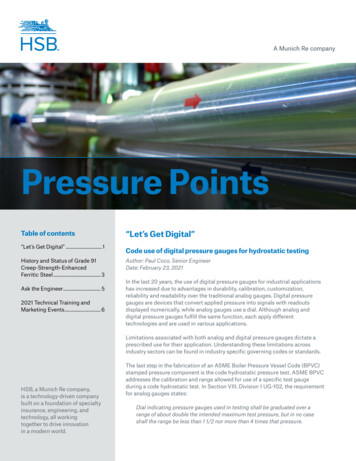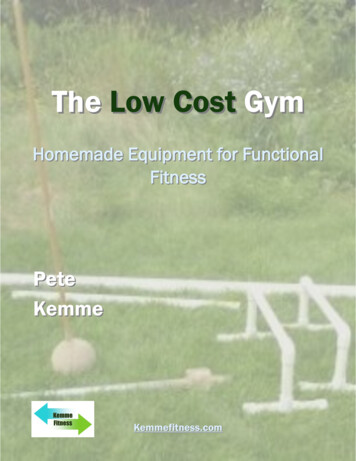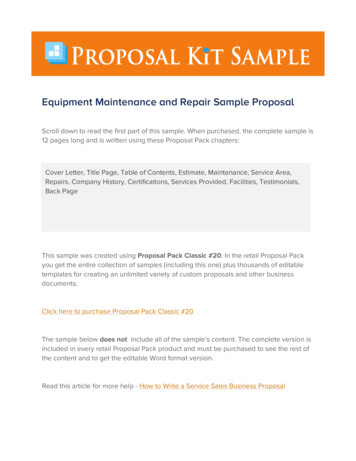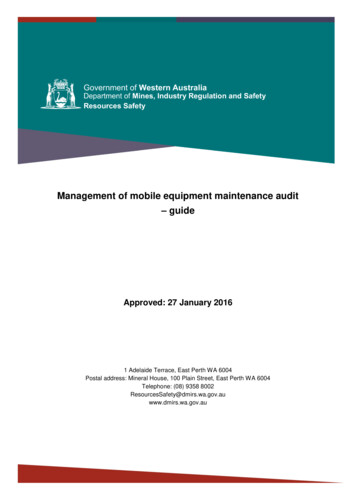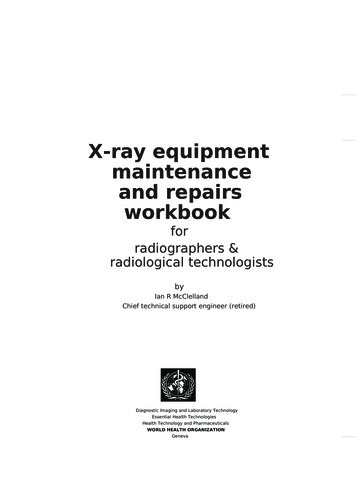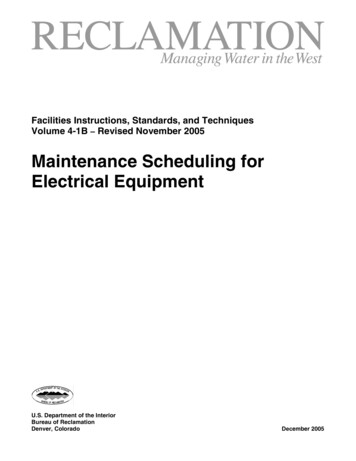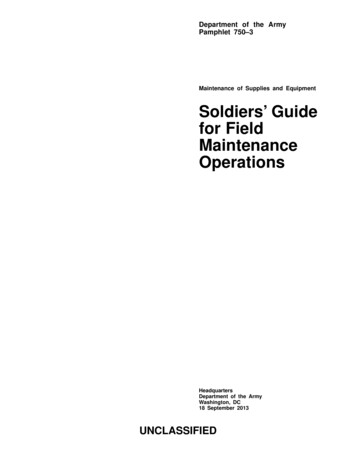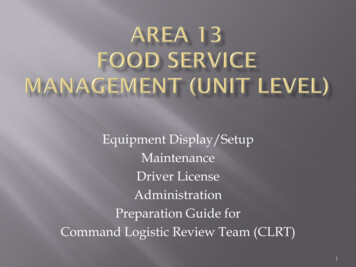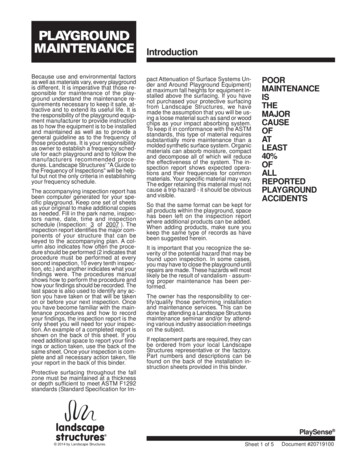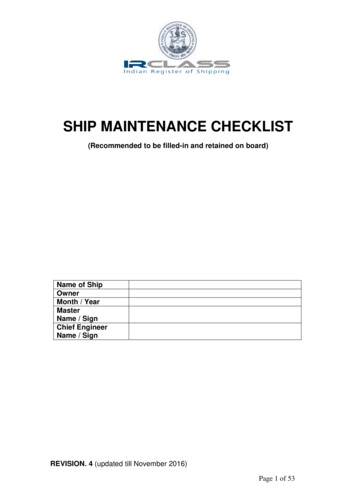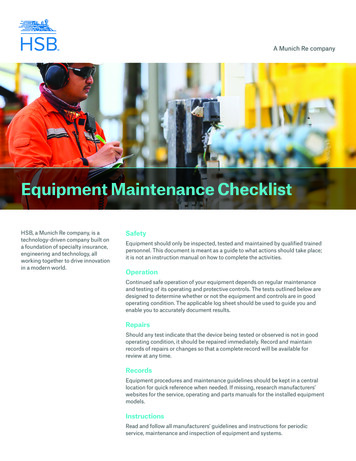
Transcription
Equipment Maintenance ChecklistHSB, a Munich Re company, is atechnology-driven company built ona foundation of specialty insurance,engineering and technology, allworking together to drive innovationin a modern world.SafetyEquipment should only be inspected, tested and maintained by qualified trainedpersonnel. This document is meant as a guide to what actions should take place;it is not an instruction manual on how to complete the activities.OperationContinued safe operation of your equipment depends on regular maintenanceand testing of its operating and protective controls. The tests outlined below aredesigned to determine whether or not the equipment and controls are in goodoperating condition. The applicable log sheet should be used to guide you andenable you to accurately document results.RepairsShould any test indicate that the device being tested or observed is not in goodoperating condition, it should be repaired immediately. Record and maintainrecords of repairs or changes so that a complete record will be available forreview at any time.RecordsEquipment procedures and maintenance guidelines should be kept in a centrallocation for quick reference when needed. If missing, research manufacturers’websites for the service, operating and parts manuals for the installed equipmentmodels.InstructionsRead and follow all manufacturers’ guidelines and instructions for periodicservice, maintenance and inspection of equipment and systems.
HSBEquipment Maintenance ChecklistPage 2/5Prepare!You should have emergency shutdown procedures in place for critical equipment. Educate keyemployees on how to implement those procedures.Don’t wait for equipment to fail! Pump and system – Check circulator pumps for proper operation and leakypacking. Examine check valves, makeup water valves, expansion tank, andother parts of the system.Low-water fuel cut-off (if applicable) – Drain float chamber while boiler isrunning. This should interrupt the circuit and stop the burner.Burner operation – If the burner starts with a puff or operates roughly, callyour service personnel at once!Safety/relief valve – Pull try-lever to full open position with pressure on theboiler. Release try-lever to allow the valve to snap closed. AnnuallyPump and system – Check feedwater and condensate pumps for properoperation and leaky packing. Examine traps, check valves, makeup floatvalves, expansion or condensate tank, and other parts of the system.Low-water fuel cut-off – Drain float chamber while boiler is running. Thisshould interrupt the circuit and stop the burner.Burner operation – If the burner starts with a puff or operates roughly, callyour service personnel at once!Safety/relief valve – Pull try-lever to full open position with pressure on theboiler. Release try-lever to allow the valve to snap closed.Water column or gauge glass – Open the drain valve quickly to void a smallquantity of water. Water level should return quickly when the drain valve isclosed.Quarterly MonthlyPump and system – Check feedwater and condensate pumps for properoperation and leaky packing. Examine traps, check valves, makeup floatvalves, expansion or condensate tank and other parts of the system.Low-water fuel cut-off – Drain float chamber while boiler is running. Thisshould interrupt the circuit and stop the burner.Burner operation – If the burner starts with a puff or operates roughly, callyour service personnel at once!Safety/relief valve – Pull try-lever to full open position with pressure on theboiler. Release try-lever to allow the valve to snap closed.Water column or gauge glass – Open the drain valve quickly to void a smallquantity of water. Water level should return quickly when the drain valve isclosed.WeeklyWhat to look for/What to ersSteam heating highpressureOver - 15psiCaution - All steamand waterdischarges must bepiped to a safeplace.Steam heating lowpressure15psi and underCaution – All steamand waterdischarges must bepiped to a safeplace.Hot water heating160psi & 250ºF orlessCaution – All waterdischarge must bepiped to a safeplace.421422441 401423442 401423442
HSBEquipment Maintenance ChecklistAnnuallyQuarterlyMonthlyWeeklyWhat to look for/What to doDailyEquipment/SystemPage 3/5Referencedocumentnumber 406407425445448Air conditioning & refrigerationHermeticCaution - Alwaysde-energizeelectrical equipmentbefore testing,cleaning orperformingmaintenance.Non-hermeticCaution – Alwaysde-energizeelectrical equipmentbefore testing,cleaning orperformingmaintenance.Motors – Take insulation resistance readings of motor windings. If lessthan manufacturer’s or NETA recommendations, do not start themotor. Check for the cause of low resistance.Motor controls – Inspect starter contacts for deterioration, pitting,corrosion, etc.; check terminal connections for tightness; examineoverload protection for adequate size and defects; determine thattiming devices have correct operating sequence; check mechanicallinkage for binding and looseness.Fans – Check for broken, cracked, bent or loose blades or hubs; checkshaft and bearings; check belt tension and condition.Filters – Clean or replace all evaporator air filters. If a water-cooledcondenser is used, the water side must be kept clean.Motors – Take insulation resistance readings of motor windings. If lessthan manufacturer’s or NETA recommendations, do not start themotor. Check for the cause of low resistance. Check air ventilationopenings on open-type motors for obstruction. Check bearings onopen-type motors for proper lubrication.Motor controls – Inspect starter contacts for deterioration, pitting,corrosion, etc.; check terminal connections for tightness; examineoverload protection for adequate size and defects; determine thattiming devices have correct operating sequence; check mechanicallinkage for binding and looseness.Fans – Check for broken, cracked, bent or loose blades or hubs; checkshaft and bearings; check belt tension and condition.Filters – Clean or replace all evaporator air filters. If a water-cooledcondenser is used, the water side must be kept clean.Moisture indicator – Observe to determine any change in the indicatorchemical color or the presence of gas bubbles in the liquid refrigerant.In either case your service technician should be called.Oil sight glass – Observe the glass to establish that sufficient oil is inthe compressor crankcase. Oil leaks should be repaired immediately.Any change in normal oil level should be investigated by your servicetechnician.Temperature – In-operation temperature levels for the compressorsuction and discharge should be established and recorded. Anyunusual change in these temperatures should be brought to theattention of your service technician.Pressure – Operating pressure levels should be established andrecorded. Any unusual change in these pressures should be brought tothe attention of your service technician. 406407425445448
HSBEquipment Maintenance ChecklistAnnuallyQuarterlyMonthlyWeeklyWhat to look for/What to doDailyEquipment/SystemPage 4/5ReferencedocumentnumberElectrical / electronicElectricaldistribution systemCaution - Alwaysde-energizeelectrical equipmentbefore testing,cleaning orperformingmaintenance.Electronic &computerequipmentCaution – Alwaysde-energizeelectrical equipmentbefore testing,cleaning orperformingmaintenance.Cool – All vent and air circulation openings must be clear and operational.Electrical loads should be reviewed and corrected to ensure that circuits areproperly loaded and balanced.Clean – Dust and/or dirt accumulations should be removed from theequipment and surroundings. Equipment should be thoroughly cleanedinside and outside. Space in electrical rooms and switchgear enclosuresshould not be used for storing tools, supplies, or other material.Dry – Precaution should be taken to prevent steam, chemicals, moisture orcondensation from entering electrical enclosures.Tight – Clean and tighten all loose parts and replace any that are worn.Equipment should be manually exercised to establish that moving parts donot bind and are free to operate. Protection – Computers, associated components of the computer system,and other electronic equipment should be protected by a UL-listed surgesuppression device. Verify that vital programs and records are storedremotely and/or in an approved safe located in alow-hazard area, and protected by smoke detection and automaticsprinklers.Heat – All vent and air circulation openings must be free from obstruction.Filters should be kept clean and sound, and the fans operable.Smoke – Ensure that approved detectors are installed and maintained.Verify that the actuation of any detector results in the sounding of alarmsand the shutdown of air conditioning equipment.Dry – Precaution should be taken to prevent steam, chemicals, moisture orcondensation from entering computers or associated equipment. 420443446447 420443 MechanicalFans, blowers &intake airDeepwell pumpsFans & blowers – Check for broken, cracked, bent or loose blades or hubs;check shaft and bearings; check belt tension and condition.Vents & louvers – Inspect for damage and operation. Parts should be free ofobstructions or blockage that would prevent proper intake for combustionair. Vents must not be propped open; this may cause excessive cold air andpossible freezing of vital systems. 420443 425 Motors – Take insulation resistance readings of motor windings. If less thanmanufacturer’s or NETA recommendations, do not start the motor. Checkfor the cause of low resistance. Check air ventilation opening on open-typemotors for obstruction. Check bearings on open-type motors for properlubrication.Motor controls – Inspect starter contacts for deterioration, pitting,corrosion, etc.; check terminal connections for tightness; examine overloadprotection for adequate size and defects; check mechanical linkage forbinding and looseness. Misc.Water heatersRelief valve – Pull try-lever to full open position with pressure on theequipment. Release try-lever to allow the valve to snap closed. Caution – Alldischarges must be piped to a safe place.Food preparationequipment,pressurizedcookers, steamkettles & appliancesSee “Commercial Cooking Equipment Cleaning & Maintenance procedures”wallchart.Reference documents via HSB.comReference documents for all of the abovechecklist items are available through HSB.com.National toll-free inspection hotlineInspection questions, requests for reference documents or statusof scheduled inspections can be made directly to HSB’s nationalInspection Hotline. 423438Telephone: 800-333-4677Fax: 800-292-4083E-mail:NSCINSP hotline@hsb.com
HSBEquipment Maintenance ChecklistPage 5/5Keep a record of your service contractors for quick referenceService ContractorCompanyNameTelephoneFaxHeatingCooling and RefrigerationElectricalPlumbingUtilityOtherThis article is intended for information purposes only and does not modify or invalidate any of the provisions, exclusions, terms or conditions of your policy. Pleaserefer to your policy for actual terms. All recommendations are general guidelines and are not intended to be exhaustive or complete, nor are they designed to replaceinformation or instructions from the manufacturer of your equipment. Contact your equipment service representative or manufacturer with specific questions.HSBOne State StreetP.O. Box 5024Hartford, CT 06102-5024Tel: (800) 472-1866 2020 The Hartford Steam Boiler Inspection and Insurance Company. All rights reserved.HSB.comES433 (Revision 06/2020)
The applicable log sheet should be used to guide you and enable you to accurately document results. Repairs Should any test indicate that the device being tested or observed is not in good operating condition, it should be repaired immediately. Record and maintain records of repairs or changes so that a complete record will be available for review at any time. Records Equipment procedures and
